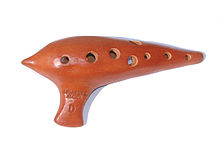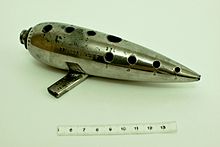ocarina
The ocarina (from ital . Ocarina , literally "little goose"), instrumental flute , also ball flute , is a small one-piece wind instrument with a round shape, which, according to the type of sound generation, the flutes without a trained beak or the flutes with an existing core gap the magnetic resonance flutes. Okarinas are made of fired and glazed clay , air-dried clay, porcelain , wood or a calabash . However, other materials are also used for special requirements, such as B. plastic (inexpensive and more robust than clay, therefore often used by children) or metal (very robust).
Design
The name comes from Emilia-Romagna and means something like "goose". The clay ocarinas, developed there and played in alpine folk music, are played with both hands and have four to twelve holes, depending on the model (with the double and triple system, however, significantly more). A wide variety of shapes are created, such as pear-shaped, cushion-shaped and beet-shaped. Also in a wide variety of animal forms, such as B. turtles, one can get ocarinas. The Inca ocarina has four holes on the front and two on the back (for the thumbs).
African vessel flutes consist of a small calabash or the stone shell of another fruit. The blowing edge is at the upper opening at the narrow end of the calabash. On both opposite sides there is an opening for the index finger of the left and right hand. Vessel flutes are known in Mozambique , the Venda in South Africa and Uganda , among others . In Uganda they are called kigwari, ebundi and kigwara. The wooden epudi (Pl. Mapudi ) of the Bassonge in the Congo is used by hunters as a signaling instrument.
Experts assume that ocarinas are over 12,000 years old, they were represented in many ancient high cultures and were also played by the Maya , Inca and Aztecs . There they were mostly in the shape of birds or other animals, while the Xun vessel flutes in the ancient Chinese Empire were rather egg-shaped.
Clay ocarinas
history
In the middle of the 19th century, the Italian clay burner Giuseppe Donati from Budrio developed the beet-shaped shape that is prevalent today with a range of one and a half octaves, the 10-hole ocarina. He built his instruments in several sizes, from the small soprano ocarina to the large bass ocarina. The first public appearance of an ocarina quintet took place in Budrio in 1863.
On the basis of Donati's 10-hole ocarina, Takashi Aketagawa developed the first 12-hole ocarina in 1928, a design that is very popular internationally.
Around 1965 the instrument maker Josef Plaschke from South Tyrol improved the ocarina with the help of the folk musician Franz Kofler, which has since been used in alpine folk music (see second picture). Kurt Posch from Braz in Vorarlberg developed the instrument further from 1990.
There are now dozens of ocarina manufacturers around the world who keep improving the ocarina. For example, “Hind” began to produce wooden ocarinas in the classic “sweet potato” and “walnut” shape. "Mountainocarinas" even developed "outdoor ocarinas" in the "inline" form, which are made of materials such as B. aluminum , polycarbonate , Corian and various hardwoods. In recent years, multi-chamber ocarinas have also been developed to a special extent, the "double", "triple" and "quadruple" systems, based on the multi-chamber system devised by Luigi Silvestri .
In addition to the ocarina, there are other instruments that work on the same principle. For example, the Gemshorn belongs to the ocarina family, but it is several centuries ahead of the modern ocarina developed by Donati.
Designs
- "Inca / Peruvian ocarina". The original, South American design of the ocarina. Nowadays it is mostly only sold to tourists as a souvenir . Therefore often badly or not at all.
- "Egg ocarina". Ocarina in egg shape. Mostly with a 4-hole system. Was very common in the ancient empire of China .
- "Pendant". Ocarina design designed for "hanging around the neck". Usually 4-, 5- or 6-hole system, often as the "English counterpart" according to Langley's system.
- "Inline". Elongated, recorder-like design. 8 holes on the top and 2 thumb holes on the bottom. In contrast to the “Sweet Potato”, the mouthpiece is not attached perpendicular to the ocarina or the holes, but rather “in a row”.
- "Walnut". Basically like "inline". However, a more rounded design.
- "Blockarina". A 4-hole ocarina invented by Richard Voss. Thanks to a sliding piston, it can be lowered by up to a whole tone.
- Transverse / Budrio Ocarina. Oval shape; rounded on one side, tapering on the other side. The mouthpiece is attached vertically / at a 90 ° angle to the ocarina or the holes. Original design by Giuseppe Donati .
range
- Triple system: Special ocarina with 3 octaves range, over 30 holes (Songbird, Hind, Focalink, Maparam type)
- Double system: Ocarina with 2 octaves range, over 20 holes (Songbird, Hind, Focalink, Maparam type)
- 12-hole system: St. Louis Ocarina, Songbird: 1 octave and 5 chromatic tones
- 10-hole system: Construction type Rotter, Plaschke, Posch, Songbird: 1 octave and 3 tones chromatic
- 8-hole system (medium to easy play): c, d, e, f, g, a, h, c
- 7-hole system, rotter type: 1 octave chromatic
- 4-hole system (English design according to Langley): 1 octave chromatic. In a variant with two thumb holes (a total of 6 holes) you get 1 octave and 2 tones chromatic.
- 4-hole system (easy ocarina, for early musical education and for people without knowledge of music notes): 6 tones (c, d, e, f, g, a) - semitone steps also possible.
Pitches
| pitch | Mood | Range* | ||
|---|---|---|---|---|
| Piccolo | c '' ' | C6 | c '' '- f' '' ' | C6-F7 |
| soprano | G'' | G5 | g '' - c '' '' | G5-C7 |
| Old | c '' | C5 | c '' - f '' ' | C5-F6 |
| tenor | G' | G4 | g'– c '' ' | G4-C6 |
| bass | c ' | C4 | c'-f '' | C4-F5 |
| double bass | c | C3 | CD'' | C3-D4 |
| * Typical range of a 10/12 hole ocarina | ||||
Further use
Movies
- In the classic war film Stalag 17 (1953), a prisoner playing ocarina appears.
- The theme song for Two Glorious Scoundrels features ocarinas.
- Tapion from Dragonball Z in the movie Drachenfaust plays on an ocarina.
- In Spies am Werk (1933), an agent plays ocarina.
- In 1900 (1976) by Bertolucci one sees Okarinas played solo, as a duo, trio and as an orchestra (in the forest scenes in the 1st part) several times.
- In Monty Python's The Meaning of Life (1983), a student plays an ocarina in class.
- In My Neighbor Totoro (1988), Totoro plays an ocarina.
- In The Dark Crystal (1982) one of the podlings plays an ocarina.
Series
- In the Doug episode Doug's No Dummy , Skeeter plays an ocarina.
- Menma from the anime adaptation of Naruto has an ocarina.
music
- György Ligeti uses ocarinas and lotus flutes in his violin concerto .
- In Wild Thing by The Troggs an ocarina solo occurs.
Video games
- In The Legend of Zelda: Ocarina of Time (1998) from the video game series The Legend of Zelda , the ocarina takes on an important part of the plot.
- In Lunar: Silver Star Story (1996), Alex plays an ocarina.
- In Jade Cocoon: The Tamamayu Legend (1998) the hero Levant has an ocarina with which he can catch monsters.
- In Professor Layton and the Call of the Phantom (2009) the ocarina is, according to legend, a flute that the phantom can conjure up.
- In Sims 2 - Stranded (2007), the player has the option to play on an ocarina.
literature
- Gerlinde Haid : Ocarina. In: Oesterreichisches Musiklexikon . Online edition, Vienna 2002 ff., ISBN 3-7001-3077-5 ; Print edition: Volume 4, Verlag der Österreichischen Akademie der Wissenschaften, Vienna 2005, ISBN 3-7001-3046-5 .
- Hans Hickmann: Unknown Egyptian sound tools (aërophone). II. Conch pipes and vessel flutes . In: Die Musikforschung, 8th year, issue 2/3, 1955, pp. 314–318.
- Anton Hirschmugl: The Okarina (Steirisches Volksliedwerk (Hrsg.): Sentences and opposites - contributions to folk culture ). Weishaupt, Graz 1998, ISBN 3-7059-0068-4 .
Web links
- ocarinaforest.com
- ocarina.at
- Fabio plays the Muse Ocarina in Church of St. Agatha. Youtube video
- The ocarina in alpine folk music
Individual evidence
- ^ Gerhard Kubik : East Africa. Music history in pictures (Volume 1: Ethnic Music . Delivery 10). Deutscher Verlag für Musik, Leipzig 1982, p. 96f.
- ^ Alan P. Merriam: The Epudi: A Basongye Ocarina. In: Ethnomusicology, Vol. 6, No. 3, September 1962, pp. 175-180.
- ^ Ocarina History. ( Memento of the original from March 30, 2015 in the Internet Archive ) Info: The archive link was inserted automatically and has not yet been checked. Please check the original and archive link according to the instructions and then remove this notice. ocarinaforest.com


